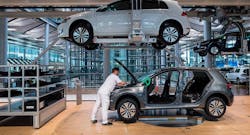VW CEO Sees Cost of Electric Car Lineup as Higher Than Expected
Volkswagen AG warned that its ambitious plan to offer an electric version of each model will cost more than it estimated, forcing the world’s largest carmaker to deepen an efficiency push to meet the spending demands.
VW had originally earmarked the shift to battery power to cost 20 billion euros (US$23 billion). Now Chief Executive Officer Herbert Diess says this won’t suffice, without providing a new figure. The company needs to reduce expenses more to be able to invest in future technology and weather crises, he said.
“The burden for our company, such as the cost of bringing to market electric cars, will be higher than expected,” Diess said in a joint interview with labor head Bernd Osterloh in VW’s internal newsletter. “This is particularly so since some of our competitors have been making more progress.”
Record spending demands to develop lineups of electric cars to keep up with tightening regulation on emissions is weighing on carmakers’ bottom lines. Mercedes-Benz maker Daimler AG, unveiling its first standalone battery car in Stockholm last week, also said its outlays for a model range of 10 fully electric cars by 2022 will be higher than an initial estimate of 10 billion euros. Volkswagen, whose Audi brand is showing off the electric e-tron crossover in San Francisco next week, plans to add some 300 plug-in hybrid and battery car versions by 2030.
Since a 2016 landmark labor pact, the Wolfsburg-based company has started to reap benefits from reorganizing its sprawling universe of 12 nameplates and has lifted profitability at its namesake brand. Group operating profit before special items last year rose to 7.4% of sales from 6.4% in 2016. A group operating return of as much as 8% would allow the company to weather tough times, he said.
“We need higher profits to finance our future,” said Diess. “Four percent is a minimum, 5% to 6% allow for some future investments and with 7% to 8% we’re crisis-ready.”
By Elisabeth Behrmann, Christoph Rauwald and Phil Serafino
About the Author
Bloomberg
Licensed content from Bloomberg, copyright 2016.
